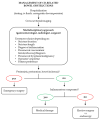Fibrostenosing Crohn's Disease: Pathogenetic Mechanisms and New Therapeutic Horizons
- PMID: 38928032
- PMCID: PMC11204249
- DOI: 10.3390/ijms25126326
Fibrostenosing Crohn's Disease: Pathogenetic Mechanisms and New Therapeutic Horizons
Abstract
Bowel strictures are well recognized as one of the most severe complications in Crohn's disease, with variable impacts on the prognosis and often needing surgical or endoscopic treatment. Distinguishing inflammatory strictures from fibrotic ones is of primary importance due to the different therapeutic approaches required. Indeed, to better understand the pathogenesis of fibrosis, it is crucial to investigate molecular processes involving genetic factors, cytokines, alteration of the intestinal barrier, and epithelial and endothelial damage, leading to an increase in extracellular matrix synthesis, which ultimately ends in fibrosis. In such a complex mechanism, the gut microbiota also seems to play a role. A better comprehension of molecular processes underlying bowel fibrosis, in addition to radiological and histopathological findings, has led to the identification of high-risk patients for personalized follow-up and testing of new therapies, primarily in preclinical models, targeting specific pathways involving Transforming Growth Factor-β, interleukins, extracellular matrix balance, and gut microbiota. Our review aims to summarize current evidence about molecular factors involved in intestinal fibrosis' pathogenesis, paving the way for potential diagnostic biomarkers or anti-fibrotic treatments for stricturing Crohn's disease.
Keywords: Crohn’s disease; anti-fibrotic treatments; intestinal fibrosis.
Conflict of interest statement
The authors declare no conflicts of interest.
Figures



References
-
- Gasche C., Scholmerich J., Brynskov J., D’Haens G., Hanauer S.B., Irvine E.J., Jewell D.P., Rachmilewitz D., Sachar D.B., Sandborn W.J., et al. A Simple Classification of Crohn’s Disease: Report of the Working Party for the World Congresses of Gastroenterology, Vienna 1998. Inflamm. Bowel Dis. 2000;6:8–15. doi: 10.1097/00054725-200002000-00002. - DOI - PubMed
-
- Silverberg M.S., Satsangi J., Ahmad T., Arnott I.D.R., Bernstein C.N., Brant S.R., Caprilli R., Colombel J.-F., Gasche C., Geboes K., et al. Toward an Integrated Clinical, Molecular and Serological Classification of Inflammatory Bowel Disease: Report of a Working Party of the 2005 Montreal World Congress of Gastroenterology. Can. J. Gastroenterol. 2005;19((Suppl. A)):5A–36A. doi: 10.1155/2005/269076. - DOI - PubMed
Publication types
MeSH terms
Substances
LinkOut - more resources
Full Text Sources
Medical

